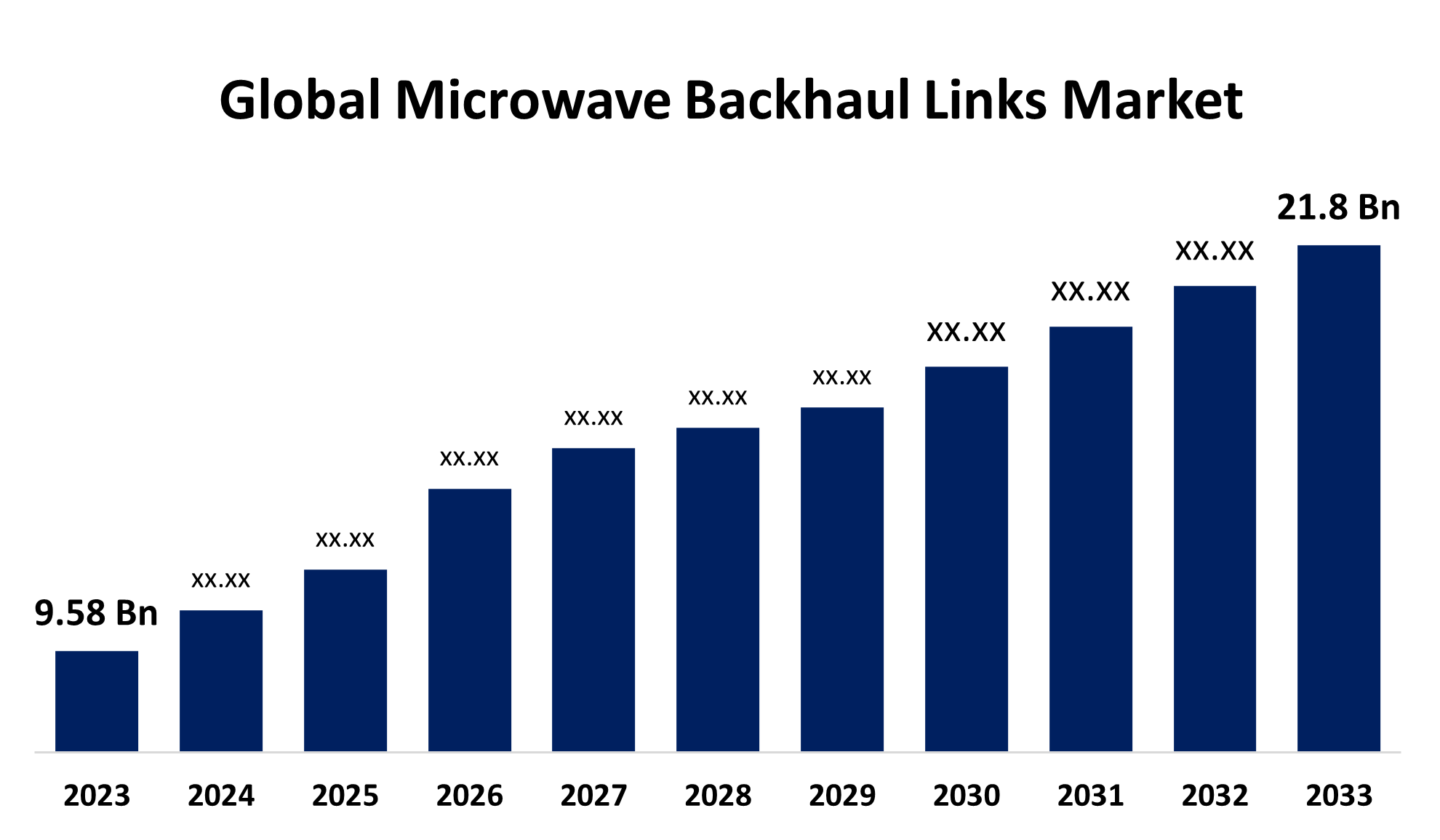Global Microwave Backhaul Links Market Size, Share, and COVID-19 Impact Analysis, By Product (Below 500 MHz, 500 MHz-2 GHz, and Above 3 GHz), By Application (Telecommunications, Broadcasting, Defense, and Others), and By Region (North America, Europe, Asia Pacific, Latin America, Middle East, and Africa), Analysis and Forecast 2023 - 2033
Industry: Information & TechnologyGlobal Microwave Backhaul Links Market Insights Forecasts to 2033
- The Global Microwave Backhaul Links Market Size was Valued at USD 9.58 Billion in 2023
- The Market Size is Expected to Grow at a CAGR of around 8.57% from 2023 to 2033
- The Worldwide Microwave Backhaul Links Market Size is Expected to Reach USD 21.8 Billion by 2033
- North America is Expected to Grow the fastest during the forecast period.

Get more details on this report -
The Global Microwave Backhaul Links Market Size is anticipated to exceed USD 21.8 Billion by 2033, Growing at a CAGR of 8.57% from 2023 to 2033.
Market Overview
The industry that offers microwave communication solutions for high-capacity data transfer between network nodes is known as the microwave backhaul links market. These solutions are commonly employed in wireless networking and telecommunications infrastructures to establish point-to-point communication links between different network locations. The market's main growth drivers are the increase in demand for high-speed mobile internet and the requirement for a strong communication infrastructure. The need for microwave backhaul links is anticipated to rise sharply as telecom companies work to offer seamless connectivity. The quick spread of mobile devices and the resulting rise in mobile data traffic are two major growth factors propelling the market for microwave backhaul links. Higher bandwidth and quicker data transfer rates are now essential with the introduction of 5G technology. By providing high-capacity data transfer over long distances, microwave backhaul lines provide an effective solution that makes it easier to expand sophisticated mobile networks.
Report Coverage
This research report categorizes the global microwave backhaul links market based on various segments and regions forecasts revenue growth and analyzes trends in each submarket. The report analyses the key growth drivers, opportunities, and challenges influencing the global microwave backhaul links market. Recent market developments and competitive strategies such as expansion, product launch, and development, partnership, merger, and acquisition have been included to draw the competitive landscape in the market. The report strategically identifies and profiles the key market players and analyses their core competencies in each sub-segment of the global microwave backhaul links market.
Global Microwave Backhaul Links Market Report Coverage
| Report Coverage | Details |
|---|---|
| Base Year: | 2023 |
| Market Size in 2023: | USD 9.58 Billion |
| Forecast Period: | 2023 – 2033 |
| Forecast Period CAGR 2023 – 2033 : | 8.57% |
| 023 – 2033 Value Projection: | USD 21.8 Billion |
| Historical Data for: | 2019-2022 |
| No. of Pages: | 246 |
| Tables, Charts & Figures: | 113 |
| Segments covered: | By Product, By Application, By Region and COVID-19 Impact Analysis. |
| Companies covered:: | Ericsson, Huawei Technologies Co., Ltd., Nokia Corporation, ZTE Corporation, NEC Corporation, Ceragon Networks Ltd., Siklu Communication Ltd., DragonWave-X, Aviat Networks, Inc., Intracom Telecom, SIAE Microelettronica S.p.A., Mimosa Networks, Inc., Proxim Wireless Corporation, and Other Key Vendors. |
| Pitfalls & Challenges: | COVID-19 Impact, Challenges, Future, Growth, & Analysis |
Get more details on this report -
Driving Factors
The market expansion for microwave radio backhaul links is driven by several factors. A major motivator is the growing demand for improved connectivity brought on by the proliferation of IoT (Internet of Things) devices. The market for microwave backhaul solutions is projected to grow significantly as the global IoT market is predicted to reach USD 3,267.4 Billion by 2033 . The need for microwave backhaul connectivity also increases as operators switch to 5G networks. Additionally, the deployment of 5G technology, the growth in connected devices, and the growing demand for high-bandwidth applications like streaming and online gaming are the main reasons why it is anticipated that by 2025, U.S. mobile data traffic will surpass 49 exabytes per month. The market for microwave backhaul links is growing as a result of the substantial increase in data traffic, which calls for strong and dependable backhaul solutions. Furthermore, the industry is expanding as a result of governments and private companies investing more in telecommunications infrastructure. In order to close the digital gap and increase connection in isolated and underserved areas, developing nations are concentrating especially on expanding their communication networks. Since microwave backhaul links provide a dependable and affordable way to increase network coverage, these initiatives are propelling its development.
Restraints & Challenges
The rivalry from alternative backhaul systems, like satellite and fiber optic, is one of the main obstacles. In many densely populated urban locations, fiber optics are the favored option because to their exceptionally high data speeds and low latency.
Market Segmentation
The global microwave backhaul links market share is classified into product and application.
- The above 3 GHz segment held the largest share in 2023 and is expected to grow at a significant CAGR during the forecast period.
Based on the product, the global microwave backhaul links market is categorized as below 500 MHz, 500 MHz-2 GHz, and above 3 GHz. Among these, the above 3 GHz segment accounted for the largest share in 2023 and is expected to grow at a significant CAGR during the forecast period. Product-type frequencies above 3 GHz are used by the most popular microwave backhaul link systems. Higher frequency bands, from 3GHz to 300GHz, are supported by 5G.
- The telecommunications segment held the largest share in 2023 and is expected to grow at a significant CAGR during the forecast period.
Based on the application, the global microwave backhaul links market is categorized as telecommunications, broadcasting, defense, and others. Among these, the telecommunications segment held the largest share in 2023 and is expected to grow at a significant CAGR during the forecast period. In order to interconnect base stations and guarantee smooth data transfer throughout the network, microwave backhaul lines are necessary. Because 5G technology necessitates high-capacity, low-latency connections, its implementation is dramatically increasing the need for microwave backhaul solutions in the telecommunications sector.
Regional Segment Analysis of the Global Microwave Backhaul Links Market
- North America (U.S., Canada, Mexico)
- Europe (Germany, France, U.K., Italy, Spain, Rest of Europe)
- Asia Pacific (China, Japan, India, Rest of APAC)
- South America (Brazil and the Rest of South America)
- The Middle East and Africa (UAE, South Africa, Rest of MEA)
Asia Pacific is projected to hold the largest share of the global microwave backhaul links market over the forecast period.

Get more details on this report -
Asia Pacific is projected to hold the largest share of the global microwave backhaul links market over the forecast period. Leading nations like China, India, and Japan are implementing cutting-edge communication infrastructure to meet the rising demand for mobile services and high-speed internet. Significant investments in telecom infrastructure are being made in the region as a result of both private sector participation and government initiatives. In Asia Pacific, the need for microwave backhaul solutions is being further driven by the ongoing growth of metropolitan areas and the emphasis on improving connection in rural areas.
North America is expected to grow at the fastest CAGR growth of the global microwave backhaul links market during the forecast period. There are large investments being made to update the region's current infrastructure, and the rollout of 5G networks is one of the main drivers of growth. The need for high-capacity, low-latency backhaul solutions is being driven by the pioneering 5G deployment in the US and Canada. Further driving market expansion in North America is the growing emphasis on improving connections in rural and isolated locations. The region's strong telecom infrastructure and technical improvements should support the market's continuing expansion.
Competitive Analysis:
The report offers the appropriate analysis of the key organizations/companies involved within the global microwave backhaul links market along with a comparative evaluation primarily based on their product offering, business overviews, geographic presence, enterprise strategies, segment market share, and SWOT analysis. The report also provides an elaborative analysis focusing on the current news and developments of the companies, which includes product development, innovations, joint ventures, partnerships, mergers & acquisitions, strategic alliances, and others. This allows for the evaluation of the overall competition within the market.
List of Key Companies
- Ericsson
- Huawei Technologies Co., Ltd.
- Nokia Corporation
- ZTE Corporation
- NEC Corporation
- Ceragon Networks Ltd.
- Siklu Communication Ltd.
- DragonWave-X
- Aviat Networks, Inc.
- Intracom Telecom
- SIAE Microelettronica S.p.A.
- Mimosa Networks, Inc.
- Proxim Wireless Corporation
- Others
Key Target Audience
- Market Players
- Investors
- End-users
- Government Authorities
- Consulting And Research Firm
- Venture capitalists
- Value-Added Resellers (VARs)
Key Market Developments
Market Segment
This study forecasts revenue at global, regional, and country levels from 2020 to 2033. Spherical Insights has segmented the global microwave backhaul links market based on the below-mentioned segments:
Global Microwave Backhaul Links Market, By Product
- Below 500 MHz
- 500 MHz-2 GHz
- Above 3 GHz
Global Microwave Backhaul Links Market, By Application
- Telecommunications
- Broadcasting
- Defense
- Others
Global Microwave Backhaul Links Market, By Regional
- North America
- US
- Canada
- Mexico
- Europe
- Germany
- UK
- France
- Italy
- Spain
- Russia
- Rest of Europe
- Asia Pacific
- China
- Japan
- India
- South Korea
- Australia
- Rest of Asia Pacific
- South America
- Brazil
- Argentina
- Rest of South America
- Middle East & Africa
- UAE
- Saudi Arabia
- Qatar
- South Africa
- Rest of the Middle East & Africa
Frequently Asked Questions (FAQ)
-
1. What is the CAGR of the global microwave backhaul links market over the forecast period?The global microwave backhaul links market size is expected to grow from USD 9.58 billion in 2023 to USD 21.8 billion by 2033, at a CAGR of 8.57% during the forecast period 2023-2033.
-
2. Which region is expected to hold the highest share of the global microwave backhaul links market?Asia Pacific is projected to hold the largest share of the global microwave backhaul links market over the forecast period.
-
3. Who are the top key players in the global microwave backhaul links market?Ericsson, Huawei Technologies Co., Ltd., Nokia Corporation, ZTE Corporation, NEC Corporation, Ceragon Networks Ltd., Siklu Communication Ltd., DragonWave-X, Aviat Networks, Inc., Intracom Telecom, SIAE Microelettronica S.p.A., Mimosa Networks, Inc., Proxim Wireless Corporation, and others.
Need help to buy this report?